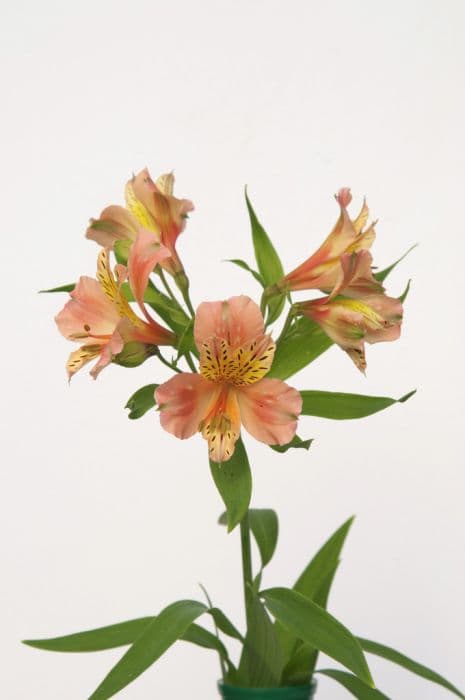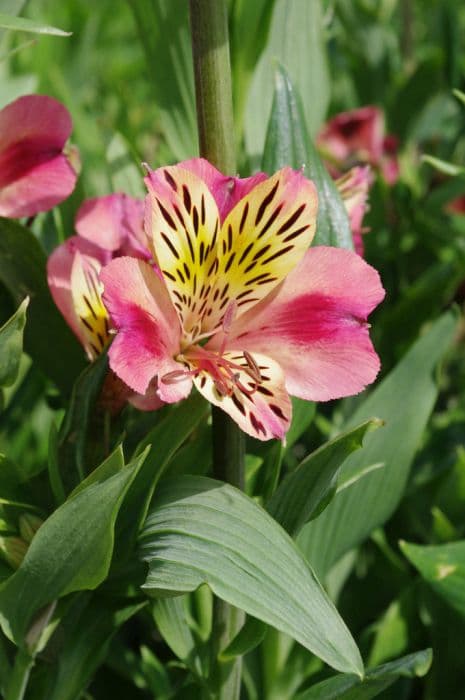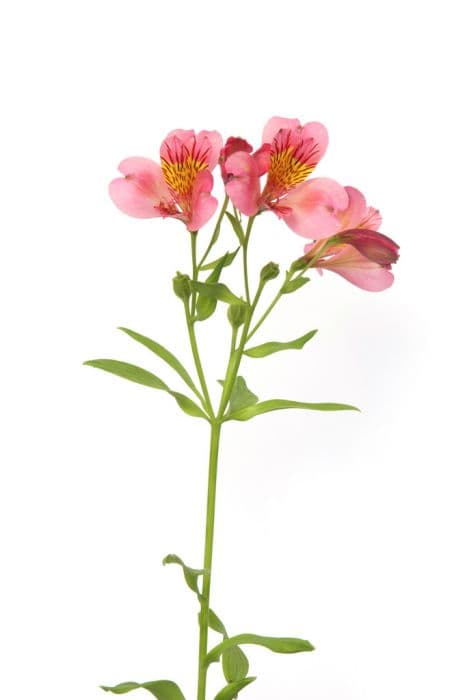Peruvian Lily Alstroemeria 'Sirius' (Planet Series)

ABOUT
Alstroemeria 'Sirius', part of the Planet Series, is a perennial plant known for its striking appearance and is commonly referred to as Peruvian Lily or Lily of the Incas. Its vibrant blooms come in an array of colors, with this variety showcasing a blend of yellow, white, and pink flowers that stand out against the contrasting dark markings and stripes. Each flower consists of six petals, which often display freckled patterns that add to their charm. These blossoms form in clusters atop sturdy, upright stems that emerge from a lush base of narrow, lance-shaped leaves. The leaves twist as they grow, such that the underside faces upwards. As a member of the Planet Series, 'Sirius' is bred for its showy flowers and resilience, making it a popular choice for garden enthusiasts looking to add a splash of color to their garden.
About this plant
 Names
NamesSynonyms
Peruvian Lily, Lily of the Incas, Parrot Lily.
Common names
Alstroemeria 'Sirius'
 Toxicity
ToxicityTo humans
The Peruvian Lily, which is a common name for the Alstroemeria 'Sirius', is not considered highly toxic to humans. However, it can cause mild irritation if ingested. The plant contains tulipalin A and B, which are compounds that could lead to symptoms like nausea, vomiting, and diarrhea if large quantities are consumed. The sap can also cause skin irritation and dermatitis in some people. Therefore, it is a good practice to handle the plant with care and not ingest any part of it.
To pets
The Peruvian Lily can be mildly toxic to pets if ingested. Symptoms of poisoning in animals such as cats and dogs may include gastrointestinal upset, resulting in vomiting or diarrhea. In some rare cases, there might be a more severe allergic reaction. It is recommended to keep the plant out of reach of pets and contact a veterinarian if you suspect your pet has ingested any part of the plant.
 Characteristics
CharacteristicsLife cycle
Perennials
Foliage type
Deciduous
Color of leaves
Green
Flower color
Mixed
Height
2-3 feet (60-90 cm)
Spread
1-2 feet (30-60 cm)
Plant type
Herb
Hardiness zones
7
Native area
South America
Benefits
 General Benefits
General Benefits- Attractive Blooms: Alstroemeria 'Sirius' showcases colorful and eye-catching flowers that enhance the visual appeal of gardens and landscapes.
- Long Bloom Period: This variety of Alstroemeria often has a long flowering season, providing consistent color and interest for an extended period.
- Cut Flower Use: The flowers of Alstroemeria 'Sirius' are long-lasting when cut, making them a popular choice for bouquets and floral arrangements.
- Drought Tolerance: Once established, this plant has a degree of drought tolerance, reducing the need for frequent watering.
- Low Maintenance: Alstroemeria 'Sirius' generally requires minimal care, making it suitable for gardeners of all skill levels.
- Attracts Pollinators: The blooms can attract bees, butterflies, and other pollinating insects, supporting biodiversity in the garden.
 Medical Properties
Medical PropertiesThis plant is not used for medical purposes.
 Air-purifying Qualities
Air-purifying QualitiesThis plant is not specifically known for air purifying qualities.
 Other Uses
Other Uses- Artistic Inspiration: The vibrant colors and unique patterns of the Peruvian lily can serve as a muse for artists and designers in creating textiles, paintings, and other forms of art.
- Edible Garnish: Although not commonly known for its edibility, the petals of Peruvian lily can be used to add a colorful garnish to salads and desserts.
- Photography Subject: Due to its striking appearance, the Peruvian lily is an excellent subject for photographers specializing in flora and botanical imagery.
- Learning Tool: Botany educators can use the Peruvian lily to teach students about plant anatomy and reproduction, particularly the complex structures of its flowers.
- Natural Dye: The colorful petals of the Peruvian lily could potentially be used to create natural dyes for fabrics or crafts.
- Ikebana (Japanese Flower Arranging): The structure and form of the Peruvian lily make it a suitable choice for traditional Japanese flower arranging practices.
- Eco-Friendly Confetti: Dried petals of the Peruvian lily can be used as a biodegradable alternative to traditional confetti at celebrations.
- Scented Sachets: Although the Peruvian lily is not notably aromatic, its dried petals could be included in potpourri or scented sachets to add color and texture.
- Plant Science Experiments: The Peruvian lily could be used in classrooms for experiments on plant growth, hybridization, and genetics due to its interesting breeding and propagation.
- Culinary Experiments: For adventurous chefs, parts of the Peruvian lily might be used as an experimental ingredient to add a unique twist to new dishes.
Interesting Facts
 Feng Shui
Feng ShuiThe Peruvian lily is not used in Feng Shui practice.
 Zodiac Sign Compitability
Zodiac Sign CompitabilityThe Peruvian lily is not used in astrology practice.
 Plant Symbolism
Plant Symbolism- Friendship - Alstroemeria, commonly known as the Peruvian Lily or Lily of the Incas, is often representative of enduring friendships due to its long-lasting nature.
- Devotion and Loyalty - With its intricate patterns and multitude of flowers that bloom together, the Peruvian Lily symbolizes a strong bond and mutual support, reflecting devotion and loyalty in relationships.
- Prosperity and Fortune - Its lush blooms and hardiness make it a symbol for growth and the ability to thrive in various conditions, thus representing prosperity and good fortune.
- Wealth and Success - The many flowers of the Peruvian Lily signify abundance, which can mean a wish for wealth and success in one's endeavors.
- Ambition - The 'Sirius' variety, named after the brightest star in the sky, can symbolize ambition and reaching for one's brightest potential.
 Water
WaterPeruvian lilies, as Alstroemeria 'Sirius' is commonly known, prefer consistent moisture, so watering should be done when the top inch of soil feels dry to the touch. Typically, this will mean watering about once a week, but this can vary depending on the climate and the season. During the growing season in spring and summer, you might need to water more frequently, especially if it's hot or windy, to maintain consistent soil moisture. Provide about 1 gallon of water per plant to ensure the root zone is thoroughly moistened. Decrease watering in the fall and winter when the plant is not actively growing.
 Light
LightPeruvian lilies thrive in bright, indirect sunlight or partial shade. They do best when protected from the harsh afternoon sun, so a spot that receives morning light with some afternoon shade is ideal. These conditions will promote vibrant blooms and healthy growth without the risk of scorching the foliage.
 Temperature
TemperaturePeruvian lilies are most comfortable in temperatures ranging between 65 to 75 degrees Fahrenheit. They can survive minimum temperatures down to about 23 degrees Fahrenheit, though frosts and freezes can damage the plant. The maximum temperature they can handle without stress is around 90 degrees Fahrenheit. Ideal growing conditions fall within this temperature range to avoid heat stress and cold damage.
 Pruning
PruningPeruvian lilies benefit from pruning to remove spent flowers and encourage reblooming. Deadheading, or cutting off the faded flowers, should be done regularly throughout the flowering season. Additionally, you can cut back the entire plant by about one-third in late summer or early fall to promote fresh growth and additional blooms. The best time for major pruning is after the blooming cycle is over or in early spring before new growth begins.
 Cleaning
CleaningAs needed
 Soil
SoilPeruvian lilies thrive in fertile, well-draining soil with a pH of 6.0 to 7.0. A mix of loam, compost or well-rotted manure, and a handful of sand or perlite provides the ideal soil structure for Alstroemeria 'Sirius'. Ensure the soil retains moisture but does not become waterlogged to prevent root rot.
 Repotting
RepottingPeruvian lilies typically need to be repotted every two to three years. Due to their rhizomatous roots, they prefer to be slightly pot-bound but should be moved to larger pots once they become overcrowded to ensure continual growth and bloom.
 Humidity & Misting
Humidity & MistingPeruvian lilies prefer moderate to high humidity levels, ideally around 40-60%. While they tolerate lower humidity levels, maintaining adequate humidity promotes healthy growth and flowering.
 Suitable locations
Suitable locationsIndoor
Provide bright, indirect light and keep at moderate temperatures.
Outdoor
Plant in partial shade, shelter from strong winds, ensure drainage.
Hardiness zone
7-10 USDA
 Life cycle
Life cycleAlstroemeria 'Sirius', commonly known as the Peruvian Lily or Lily of the Incas, begins its life as a dormant rhizome or tuberous root, which will sprout in the spring. Upon sprouting, the plant develops a rosette of foliage and elongated stems that bear lance-shaped leaves. As temperatures rise and the plant matures, clusters of showy, funnel-shaped flowers in a variety of colors, including yellow, red, orange, and white with characteristic streaks and spots, bloom atop the stems. Following pollination, which is aided by bees and other insects, the Peruvian Lily sets seed in capsule-like fruits, although many cultivators propagate the plant vegetatively. After the flowering period, usually late summer to fall, the plant may enter a period of dormancy, particularly in colder climates, with the foliage dying back until the next growth cycle. With appropriate care, including proper winter protection, the Peruvian Lily can re-emerge from its rhizomes year after year to complete its perennial life cycle.
 Propogation
PropogationPropogation time
Spring-Early Summer
Propogation: The Alstroemeria 'Sirius', commonly known as the Peruvian Lily or Lily of the Incas, can be effectively propagated by division, which is the most popular method. The best time to propagate this plant is in the early spring or late fall when the plant is not in its active growing phase. To propagate by division, carefully lift the entire clump of the Peruvian Lily from the ground using a shovel or garden fork, ensuring minimal damage to the roots. Gently separate the rhizomes, which are the underground stems, by pulling or cutting them apart, taking care to leave several shoots and a good amount of root on each division. Replant the divisions at the same depth they were growing previously, spacing them about 12 to 18 inches (approximately 30 to 45 centimeters) apart to allow for ample growth. Water the newly planted divisions thoroughly to settle the soil and help reduce transplant shock. This method allows the grower to increase the number of plants efficiently while maintaining the genetic characteristics of the parent plant.




![Peruvian lily [H.R.H. Princess Alice]](/_next/image?url=https%3A%2F%2Fplants-admin.emdemapps.com%2Fimages%2Fplants%2F%2Fimages%2F604b55e81c8b0.png&w=640&q=75)
![Peruvian lily [Indian summer]](/_next/image?url=https%3A%2F%2Fplants-admin.emdemapps.com%2Fimages%2Fplants%2F%2Fimages%2F604b616bc746b.png&w=640&q=75)
![Peruvian lily [Inticancha Creamy Dark Pink]](/_next/image?url=https%3A%2F%2Fplants-admin.emdemapps.com%2Fimages%2Fplants%2F%2Fimages%2F604b5e98bea7c.png&w=640&q=75)
![Peruvian lily [Inticancha Dark Purple]](/_next/image?url=https%3A%2F%2Fplants-admin.emdemapps.com%2Fimages%2Fplants%2F%2Fimages%2F604b5381bb78f.png&w=640&q=75)
![Peruvian lily [Inticancha Imala]](/_next/image?url=https%3A%2F%2Fplants-admin.emdemapps.com%2Fimages%2Fplants%2F%2Fimages%2F604b619b522ba.png&w=640&q=75)
![Peruvian lily [Inticancha Red]](/_next/image?url=https%3A%2F%2Fplants-admin.emdemapps.com%2Fimages%2Fplants%2F%2Fimages%2F604b5aebac273.png&w=640&q=75)